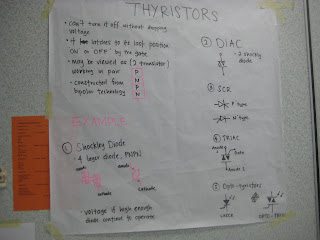After Mathematics and Physics in modules 1 and 2, the next appropriate module is module 3.
I include the syllabus from Malaysian DCA, which is similar to the EASA syllabus.
3.1 Electron Theory B1 - Level 1,
Structure and distribution of electrical charges within: atoms, molecules, ions, compounds; Molecular structure of conductors, semiconductors and insulators.
3.2 Static Electricity and Conduction (B1 L2)
Static electricity and distribution of electrostatic charges;
Electrostatic laws of attraction and repulsion;
Units of charge, Coulomb's Law; Conduction of electricity in solids, liquids, gases and a vacuum.
3.3 Electrical Terminology (B1-L1)
The following terms, their units and factors affecting them: potential difference, electromotive force, voltage, current, resistance, conductance, charge, conventional current flow, electron flow.
3.4 Generation of Electricity (B1-L1)
Production of electricity by the following methods: light, heat, friction, pressure, chemical action, magnetism and motion.
3.5 DC Sources of Electricity (B1-L2)
Construction and basic chemical action of: primary cells, secondary cells, lead acid cells, nickel cadmium cells, other alkaline cells;
Cells connected in series and parallel;
Internal resistance and its effect on a battery;
Construction, materials and operation of thermocouples;
Operation of photo-cells.
3.6 DC Circuits (B1-L2)
Ohms Law, Kirchoff's Voltage and Current Laws;
Calculations using the above laws to find resistance, voltage & current;
Significance of the internal resistance of a supply.
3.7 Resistance/Resistor (L2)
(a) Resistance and affecting factors; Specific resistance;
Resistor colour code, values and tolerances, preferred values, wattage ratings;
Resistors in series and parallel;
Calculation of total resistance using series, parallel and series parallel combinations;
Operation and use of potentiometers and rheostats;
Operation of Wheatstone Bridge.
(b) Positive and negative temperature coefficient conductance; (L1)
Fixed resistors, stability, tolerance and limitations, methods of construction;
Variable resistors, thermistors, voltage dependent resistors;
Construction of potentiometers and rheostats;
Construction of Wheatstone Bridge;
3.8 Power (L2)
Power, work and energy (kinetic and potential);
Dissipation of power by a resistor;
Power formula;
Calculations involving power, work and energy.
3.9 Capacitance/Capacitor (L2)
Operation and function of a capacitor;
Factors affecting capacitance area of plates, distance between plates, number of plates, dielectric and dielectric constant, working voltage, voltage rating;
Capacitor types, construction and function;
Capacitor colour coding;
Calculations of capacitance and voltage in series and parallel circuits;
Exponential charge and discharge of a capacitor, time constants;
Testing of capacitors.
3.10 Magnetism (B2)
(a) Theory of magnetism;
Properties of a magnet;
Action of a magnet suspended in the Earth's magnetic field;
Magnetisation and demagnetisation;
Magnetic shielding;
Various types of magnetic material;
Electromagnets construction and principles of operation;
Hand clasp rules to determine: magnetic field around current carrying conductor.
(b) Magnetomotive force, field strength, magnetic flux density, permeability, hysteresis loop, retentivity, coercive force reluctance, saturation point, eddy currents;
Precautions for care and storage of magnets.
3.11 Inductance/Inductor (L2)
Faraday's Law;
Action of inducing a voltage in a conductor moving in a magnetic field;
Induction principles;
Effects of the following on the magnitude of an induced voltage: magnetic field strength, rate of change of flux, number of conductor turns;
Mutual induction;
The effect the rate of change of primary current and mutual inductance has on induced voltage;
Factors affecting mutual inductance: number of turns in coil, physical size of coil, permeability of coil, position of coils with respect to each other;
Lenz's Law and polarity determining rules;
Back emf, self induction;
Saturation point;
Principle uses of inductors;
3.12 DC Motor/Generator Theory (L2)
Basic motor and generator theory;
Construction and purpose of components in DC generator;
Operation of, and factors affecting output and direction of current flow in DC generators;
Operation of, and factors affecting output power, torque, speed and direction of rotation of DC motors;
Series wound, shunt wound and compound motors;
Starter Generator construction.
3.13 AC Theory (L2)
Sinusoidal waveform: phase, period, frequency, cycle;
Instantaneous, average, root mean square, peak, peak to peak current values & calculations of these values, in relation to voltage, current & power;
Triangular/Square waves;
Single/3 phase principles.
3.14 Resistive (R), Capacitive (C) and Inductive (L) Circuits (L2)
circuits, parallel, series and series parallel;
Power dissipation in L, C and R circuits;
Impedance, phase angle, power factor and current calculations;
True power, apparent power and reactive power calculations.
3.15 Transformers (L2)
Transformer construction principles and operation;
Transformer losses and methods for overcoming them;
Transformer action under load and no-load conditions;
Power transfer, efficiency, polarity markings;
Calculation of line and phase voltages and currents;
Calculation of power in a three phase system;
Primary and Secondary current, voltage, turns ratio,power, efficiency;
Auto transformers.
3.16 Filters (L1)1
Operation, application and uses of the following filters: low pass, high pass, band pass, band stop.
3.17 AC Generators (L2)
Rotation of loop in a magnetic field and waveform produced;
Operation and construction of revolving armature and revolving field type AC generators;
Single phase, two phase and three phase alternators;
Three phase star and delta connections advantages and uses;
Permanent Magnet Generators.
3.18 AC Motors (L2)2
Construction, principles of operation and characteristics of: AC synchronous and induction motors both single and polyphase;
Methods of speed control and direction of rotation;
Methods of producing a rotating field: capacitor, inductor, shaded or split pole.
























